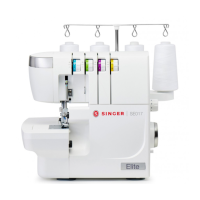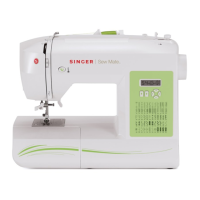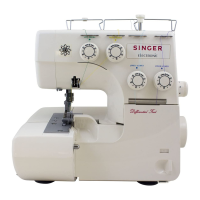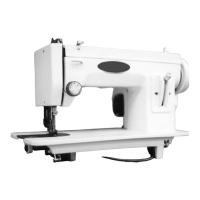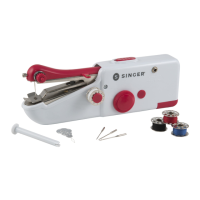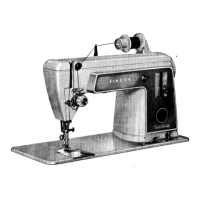Do you have a question about the Singer SE300 and is the answer not in the manual?
Covers critical DANGER and WARNINGs for safe operation of the sewing machine.
Details age limits, supervision requirements, and servicing for double-insulated products.
Identifies key components of the sewing machine through diagrams.
Lists and describes machine accessories and how to access them.
Guides on changing presser feet and removing/inserting the needle.
Recommends needle types and sizes based on fabric type.
Instructions for powering the machine and connecting the foot controller.
Explains the operation of various control buttons and levers.
Details specific component functions and installation options.
Introduces the machine's interface, touch panel, and main home screen.
Guides on choosing sewing stitches, patterns, and operating modes.
Explains how to customize stitch parameters like width and length.
Covers thread tension control and basic twin needle sewing.
Details how to adjust screen contrast, audible beep, and calibration.
Step-by-step guide for setting and winding the bobbin.
Instructions for correctly placing the upper thread spool on the spool pin.
Ensures proper placement of the bobbin into the bobbin case.
Completes the threading process by guiding thread through needle and bobbin.
Overview of available stitches and their recommended uses.
Covers starting, ending seams, and reverse stitching for seam reinforcement.
Details tack stitch, turning corners, and sewing heavy fabrics.
Explains straight, zigzag, and satin stitches and their applications.
Covers blind hem, overcasting, and the use of specialized presser feet.
Details crazy patch technique and using the all-purpose foot.
Techniques for knit fabrics, temporary stitching, and zigzag variations.
Instructions for sewing buttons and inserting zippers into garments.
Techniques for quilting and finishing zipper tabs.
Instructions for reinforcing seams, mending, and creating buttonholes.
Advanced buttonhole creation and eyelet stitching techniques.
Covers continuous decorative patterns and sewing lightweight fabrics.
Decorative techniques, accessing hard-to-reach areas, and specialized stitching.
Creates decorative effects and parallel stitches using two needles.
How to choose stitch patterns and letters to create a sequence.
Managing patterns and letters within a sequence using cursor keys.
Customizing sequence settings and storing them in memory.
Executing stored stitch sequences and using single sequence mode.
Initial setup steps for attaching the embroidery unit and foot.
Understanding start-up messages and adjusting machine settings for embroidery.
Explains the importance and types of fabric and stabilizer for quality embroidery.
A reference guide for selecting embroidery materials based on project.
Critical steps for securing fabric in the hoop and attaching it to the machine.
Handling designs via USB, design books, software, and machine updates.
Navigating the design selection interface and understanding the collection.
Process for choosing designs from the machine or USB stick.
Modifying designs through rotation, mirroring, scaling, and positioning.
Managing hoop size, position, and other embroidery options.
Using tracing, basting, and monochrome modes for design preparation.
Interface for monitoring embroidery progress and stitch count.
Steps to start embroidery, manage thread changes, and complete the design.
Using the machine's built-in fonts for creating embroidered text.
Explains various machine alerts for common operational issues.
Covers more messages related to operations, USB data, and program errors.
Instructions for routine cleaning of the hook race and feed dogs.
Provides solutions for frequent sewing issues and machine performance problems.
Lists specifications like voltage, power consumption, dimensions, and weight.
Covers critical DANGER and WARNINGs for safe operation of the sewing machine.
Details age limits, supervision requirements, and servicing for double-insulated products.
Identifies key components of the sewing machine through diagrams.
Lists and describes machine accessories and how to access them.
Guides on changing presser feet and removing/inserting the needle.
Recommends needle types and sizes based on fabric type.
Instructions for powering the machine and connecting the foot controller.
Explains the operation of various control buttons and levers.
Details specific component functions and installation options.
Introduces the machine's interface, touch panel, and main home screen.
Guides on choosing sewing stitches, patterns, and operating modes.
Explains how to customize stitch parameters like width and length.
Covers thread tension control and basic twin needle sewing.
Details how to adjust screen contrast, audible beep, and calibration.
Step-by-step guide for setting and winding the bobbin.
Instructions for correctly placing the upper thread spool on the spool pin.
Ensures proper placement of the bobbin into the bobbin case.
Completes the threading process by guiding thread through needle and bobbin.
Overview of available stitches and their recommended uses.
Covers starting, ending seams, and reverse stitching for seam reinforcement.
Details tack stitch, turning corners, and sewing heavy fabrics.
Explains straight, zigzag, and satin stitches and their applications.
Covers blind hem, overcasting, and the use of specialized presser feet.
Details crazy patch technique and using the all-purpose foot.
Techniques for knit fabrics, temporary stitching, and zigzag variations.
Instructions for sewing buttons and inserting zippers into garments.
Techniques for quilting and finishing zipper tabs.
Instructions for reinforcing seams, mending, and creating buttonholes.
Advanced buttonhole creation and eyelet stitching techniques.
Covers continuous decorative patterns and sewing lightweight fabrics.
Decorative techniques, accessing hard-to-reach areas, and specialized stitching.
Creates decorative effects and parallel stitches using two needles.
How to choose stitch patterns and letters to create a sequence.
Managing patterns and letters within a sequence using cursor keys.
Customizing sequence settings and storing them in memory.
Executing stored stitch sequences and using single sequence mode.
Initial setup steps for attaching the embroidery unit and foot.
Understanding start-up messages and adjusting machine settings for embroidery.
Explains the importance and types of fabric and stabilizer for quality embroidery.
A reference guide for selecting embroidery materials based on project.
Critical steps for securing fabric in the hoop and attaching it to the machine.
Handling designs via USB, design books, software, and machine updates.
Navigating the design selection interface and understanding the collection.
Process for choosing designs from the machine or USB stick.
Modifying designs through rotation, mirroring, scaling, and positioning.
Managing hoop size, position, and other embroidery options.
Using tracing, basting, and monochrome modes for design preparation.
Interface for monitoring embroidery progress and stitch count.
Steps to start embroidery, manage thread changes, and complete the design.
Using the machine's built-in fonts for creating embroidered text.
Explains various machine alerts for common operational issues.
Covers more messages related to operations, USB data, and program errors.
Instructions for routine cleaning of the hook race and feed dogs.
Provides solutions for frequent sewing issues and machine performance problems.
Lists specifications like voltage, power consumption, dimensions, and weight.
| Type | Sewing and Embroidery Machine |
|---|---|
| Built-in Stitches | 250 |
| Embroidery Designs | 200 |
| Maximum Sewing Speed | 850 stitches per minute |
| USB Connectivity | Yes |
| Automatic Needle Threader | Yes |
| LCD Screen | Yes |
| Fonts | 6 |
| Voltage | 110V |
| Warranty | 25-year limited warranty |
| Buttonhole Styles | 13 |
| Stitch Length | Up to 5mm |
| Stitch Width | Up to 7mm |
| Included Accessories | Needles, Bobbins, Thread Spool Caps, Auxiliary Spool Pin, Spool Pin Felt, Seam Ripper, Lint Brush, Screwdrivers |
